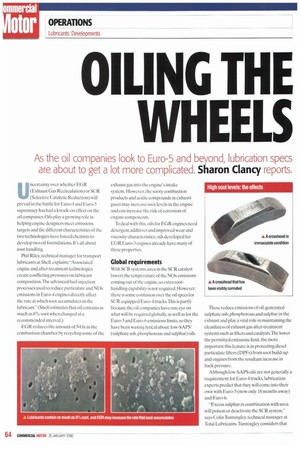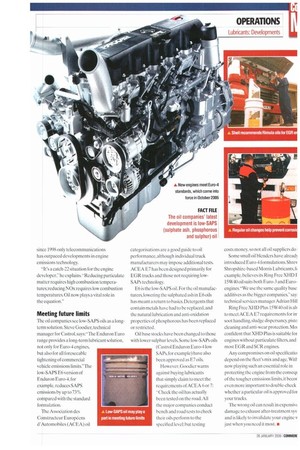OILING THE WHEELS
Page 64

Page 65

If you've noticed an error in this article please click here to report it so we can fix it.
As the oil companies look to Euro-5 and beyond, lubrication specs
are about to get a lot more complicated. Sharon Clancy reports.
Uncertainty over whether FOR (Exhaust Gas Recirculation) or SCR (Selective Catalytic Reduction) will prevail in the battle for Euro-4 and Euro-5 supremacy has had a knock-on effect on the oil companies. Oils play a growing role in helping engine designers meet emissions targets and the different characteristics of the two technologies have forced chemists to develop two oil formulations. It's all about soot handling.
Phil Riley, technical manager for transport lubricants at Shell. explains:"Associated engine and after-treatment technologies create conflicting pressures on lubricant composition.The advanced fuel-injection processes used to reduce particulate and NOx emissions in Euro-4 engines directly affect the rate at which soot accumulates in the lubricant.(Shell estimates that oil contains as much as 8% soot when changed at a recommended interval.)
EG R reduces the amount of NOx in the combustion chamber by recycling some of the
exhaust gas into the engine's intake system. However, the sooty combustion products and acidic compounds in exhaust gases may increase soot levels in the engine and can increase the risk of corrosion of engine components.
To deal with this, oils for EGR engines need detergent additives and improved wear and viscosity characteristics; oils developed for EGR Euro-3 engines already have many of these properties.
Global requirements With SCR systems, urea in the SCR catalyst lowers the temperature of the NOx emissions coming out of the engine, so extra soothandling capability is not required. However. there is some confusion over the oil specs for SCR-equipped Euro-4 trucks.This is partly because the oil companies have one eye on what will be required globally, as well as for the Euro-5 and Euro-6 emissions limits, so they have been waxing lyrical about low-SAPS' (sulphate ash, phosphorous and sulphur) oils.
These reduce emissions of oil-generated sulphate ash, phosphorous and sulphur in the exhaust and play a vital role in maintaining the cleanliness of exhaust gas after-treatment systems such as filters and catalysts.The lower the permitted emissions limit. the more important this feature is in protecting diesel particulate filters (DPFs) from soot build-up and engines from the resultant increase in back pressure.
Although low-SAPS oils are not generally a requirement for Euro-4 trucks, lubrication experts predict that they will come into their own with Euro-5 (now only 18 months away) and Euro-6.
"Excess sulphur in combination with urea will poison or deactivate the SCR system," says Colin Tunningley. technical manager at Total Lubricants. Tunningley considers that
since 1998 only telecommunications has outpaced developments in engine emissions technology.
"It's a catch-22 situation for the engine developer." he explains."Reducing particulate matter requires high combustion temperatures; reducing NOx requires low combustion temperatures. Oil now plays a vital role in the equation."
Meeting future limits 1 be oil companies see low-SAPS oils as a longterm solution. Steve Goodier.technical manager for Castrol,says:"The Enduron Euro range provides a long-term lubricant solution, not only for Euro-4 engines, but also for all foreseeable tightening of commercial vehicle emissions limits."The low-SAPS E6 version of Enduron Euro-4, for example, reduces SAPS emissions by up to 73% compared with the standard formulation.
The Association des Constructeur Europeens d'Automobiles (ACEA) oil categorisations are a good guide to oil performance, although individual truck manufacturers may impose additional tests. ACEA E7 has been designed primarily for EGR trucks and those not requiring lowSAPs technology.
E6 is the low-SAPS oil. For the oil manufacturers,lowering the sulphated ash in E6 oils has meant a return to basics. Detergents that contain metals have had lobe replaced, and the natural lubrication and anti-oxidation properties of phosphorous has been replaced or restricted.
Oil base stocks have been changed to those with lower sulphur levels.Some low-SAPs oils (Castrol Enduron Euro-4 low SAPs, for example) have also been approved as E7 oils.
However,Goodier. warns against buying lubricants that simply claim to meet the requirements of ACEA 6 or 7: "Check the oil has actually been tested on the road.All the major companies conduct bench and road tests to check their oils perform to the specified level: but testing costs money. so not all oil suppliers dol Some small oil blenders have alreacll introduced Euro-4 formulations.Shrev Shropshire-based Morris Lubricants, fc example, believes its Ring Free XHD F 15W40 oil suits both Euro-3 and Euroengines."We use the same quality base additives as the bigger companies." say! technical services manager Adrian Hill Ring Free XI-ID Plus 15W40 oil is al5 to meet ACEA E7 requirements for insoot handling, sludge dispersancy, piste cleaning and anti-wear protection. Moi confident that XHD Plus is suitable for engines without particulate filters, and • most EGR and SCR engines, Any compromises on oil specificatio depend on the flees mix and age. Wift now playing such an essential role in protecting the engine from the conseqi of the tougher emissions limits, it becor even more important to double-check whether a particular oil is approved for your trucks.
The wrong oil can result in expensivt damage Lo exhaust after-treatment sys' and is likely to invalidate your engine v just when you need it most. •
































































































































































































